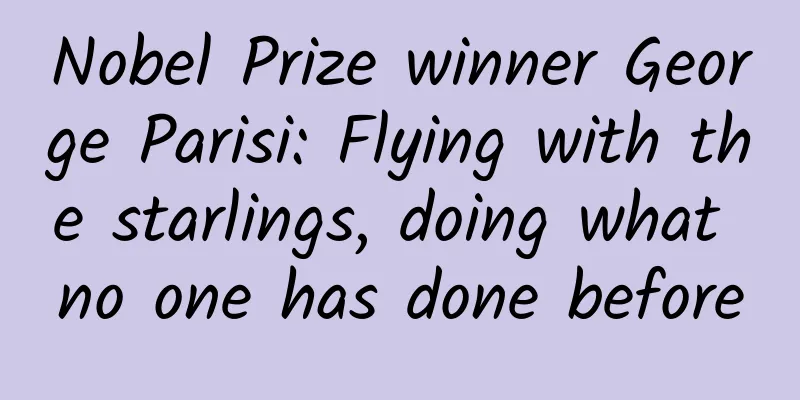Nobel Prize winner George Parisi: Flying with the starlings, doing what no one has done before

|
In 2021, Italian physicist Giorgio Parisi won the Nobel Prize in Physics for his groundbreaking contributions to the theory of complex systems, "for his discovery of the mutual influence of disorder and fluctuations in physical systems from the atomic to the planetary scale". In 1979, Parisi cleverly used the replica technique to solve the spin glass problem, which was later proved mathematically and has since become the cornerstone of the theory of complex systems. Physicists explore various disordered systems in the laboratory, but Parisi is more than that. He went outdoors and looked up at the sky: countless starlings were flying rhythmically, as if under the conductor of a band - such complex collective behavior, how do they do it? German physicist Kurt Symanzik once described Parisi as "too wild", yes, Parisi wants to fly with the starlings. Written by George Parisi Translation | Wen Zheng Interaction is an important question that can also be used to understand psychological, social and economic phenomena. In particular, we are interested in how individual members of a flock of birds can communicate with each other so that they can fly in unison, forming a group that exhibits both collective behavior and multiple structures. It is fascinating to observe the collective behavior of animals, whether it is a flock of birds in the sky, a school of fish in the water, or a group of mammals. As the sun sets, we see flocks of birds that create a magical spectacle, thousands of dancing dots of ink standing out against a colorful sky. They fly around together, never colliding or scattering, over obstacles, dispersing and gathering, constantly changing their spatial arrangement, as if a conductor is giving them instructions. We stare at these birds for a long time because there is always something new, ever-changing and unexpected. Sometimes, even in the face of this pure beauty, scientists get sick, and many questions flutter into their heads. Is this collective behavior organized by a conductor or by themselves? How does information spread so quickly throughout the flock? How can their formation change so quickly? How are the speeds and accelerations of these birds distributed? How can they turn together without colliding with each other? Could it be that the simple rules of interaction between starlings allow them to perform complex and varied collective movements, such as we observed in the sky over Rome? Starlings When you are curious and want to answer these questions, you start researching: in the past you would look it up in a book, and now you can use the Internet. If you are lucky, you will find the answer, but what if there is no answer? Because no one knows what is going on. Then, if your curiosity is really that strong, you will start to ask yourself whether you are the only one who can answer this question. This unprecedented research should not scare you, after all, this is what you are supposed to do: use your imagination to do things that have never been done before. However, you cannot spend your whole life opening armored doors that you do not have the key to . Before you set off, you must know whether you have the ability to do it and the technical tools to support you to the end. No one can guarantee that you will succeed. For example, you want your heart to fly over this obstacle, but if the obstacle is too high and your heart hits a wall, it is better to give up this idea. Complex collective behavior The flight of starlings is particularly fascinating to me because it is an important clue to my research, as well as to much of modern physics, which is about understanding the behavior of a system of many interacting components (actors). In physics, these actors can be electrons, atoms, spins, or molecules, depending on the situation, and each of them behaves in a very simple way, but when put together, they produce very complex collective behavior. Since the 19th century, statistical physics has been trying to answer questions like why liquids boil or freeze at certain temperatures, why some substances conduct electricity and transfer heat well (such as metals), while others are insulators... The answers to these questions were found long ago, but we are still searching for them. In all these physics problems, we can understand in a quantitative way how collective behavior starts from simple rules of interaction between individual players. But the challenge is to extend the applicability of statistical mechanics techniques from inanimate matter to animals, such as starlings. These results are not only relevant to ecology and evolutionary biology, but also have a long-term impact on the humanities, which study economic and social phenomena. In these disciplines, we study large numbers of people who interact with each other, so it is necessary to understand the connection between the behavior of individuals and the behavior of the group. People walking on the street in Osaka, Japan The great American physicist Philip Warren Anderson (Nobel Prize winner in 1977) published an article in 1972 entitled "The Many Are Different" (Editor's note: see "The Many Are Different: Broken Symmetries and the Nature of Scientific Hierarchy"), which reveals the following view. He believes that the increase in the number of components of a system determines not only the quantitative change of the system, but also its qualitative change. Therefore, the main conceptual problem that physics should face is to understand the relationship between microscopic rules and macroscopic behavior. Starlings To explain a problem, we must first fully understand it. So, at the beginning, we lacked a key piece of information: we had to understand how the flock of birds moved in the air, but this information was not available at the time. In fact, the large number of videos and photos of bird flocks we had at the time (which were also easily found online) were all taken from a single perspective and had no three-dimensional information at all. In a way, we were like the prisoners in Plato's cave myth, who could only see two-dimensional shadows projected on the cave wall and could not grasp the three-dimensional properties of objects. It is precisely this problem that has become another driving force for my research interest: the study of bird flock movement should be a complete topic, including experimental design, data collection and analysis, the development of computer codes for simulation, and the interpretation of experimental results to draw final conclusions. As you know, I have been working in statistical physics, and the methods of this discipline are essential for the three-dimensional reconstruction of the flight paths of starlings, but what really attracts me to this work is the participation in the experimental design and implementation. We theoretical physicists usually stay away from the laboratory and deal with abstract concepts. Solving practical problems means controlling many variables, specifically, from the resolution of the camera lens to the optimal shooting position of the camera, from the amount of data storage to the analysis technology, every detail determines the success or failure of the experiment. People who only talk about military affairs on paper have no idea how many problems they will encounter in the battlefield. I never like research away from the laboratory. Starlings are extremely interesting animals. A few hundred years ago, these birds spent the warmer months in northern Europe before wintering in northern Africa. Today, global warming is causing higher winter temperatures, and our cities are getting hotter, not only due to their increasing size but also due to the diversification of heat sources (home heating, traffic). As a result, many starlings no longer fly across the Mediterranean, but stay in some coastal cities in Italy for the winter, including Rome, where winters are much warmer than before. Starlings arrive in Rome in early November and leave in early March. Their migration is very punctual, and the timing of their migration may not be entirely determined by the temperature, but by astronomical reasons, such as the duration of daylight. In Rome, starlings roost at night in evergreen trees that can protect them from the wind and cold; during the day, when it is difficult to find food in the city, they form groups of more than a hundred and fly to the countryside outside the ring road to find food. They are gregarious animals that are used to living in groups: when they stop in a field, half of the birds eat peacefully, while the other half are around the field, carefully observing possible predators; when they come to the next field, the two sides switch roles. At night, starlings return to the warmth of the city and form large flocks that circle in the sky over Rome before roosting in the trees. But in any case, starlings are still very sensitive to the cold in winter: after a few nights of cold wind, it is easy to find many of their bodies scattered under the large trees that are not enough to protect them from the wind and cold. The choice of a roost is therefore a matter of life and death. Their dance in the twilight sky is probably a signal, visible from a distance, that there is a suitable accommodation for the night. It is like a huge waving signal flag, extremely conspicuous. I have myself seen these dances of flocks of birds from a distance of ten kilometers in the clear winter twilight. They are a gray-black spot, moving like an amoeba in the sky when there is still a ray of light on the horizon. As the light fades, the first flocks returning from the country foraging begin to fly more and more frantically, and the late flocks return to the city, eventually gathering into a flock of thousands of starlings. About half an hour after sunset, when the daylight has completely disappeared, the birds quickly fly to the roosting trees, which absorb them completely like sinkholes. Peregrine falcons often hang out near starlings, hunting for dinner. If you’re not paying attention, you won’t notice them at all, and with our attention focused on starlings, only a few people who specifically look for peregrine falcons will notice these raptors. Despite the fact that peregrine falcons have a one-meter wingspan and can reach speeds of more than 200 kilometers per hour when diving, starlings are not easy prey. In fact, if a peregrine falcon collides with a starling in flight, the peregrine’s fragile wings may break, which is a fatal accident. Therefore, peregrine falcons dare not enter the starling formation, but only wait for opportunities to capture lone ones on the edge. Faced with a peregrine falcon’s attack, the starlings respond by moving closer together, closing in, and quickly changing direction to avoid the peregrine’s deadly claws. Some of the starlings’ most dramatic formation changes are designed to deal with the peregrine’s repeated attacks, which the peregrine falcon has to launch many attacks to capture the starling. Many of the starlings’ behaviors are likely due to the need to survive these terrifying attacks. Our Experiment Now let's go back to the subject of the experiment. The first problem we encountered was how to obtain a three-dimensional image of the flock of birds and their shapes and reconstruct the three-dimensional image by combining various photos taken in succession. In theory, this is very easy to do. This problem can be solved in a simple way: we all know that in order to see the three-dimensional effect, we just need to use both eyes at the same time. Seeing from two different angles at the same time, even if both angles are as close as our eyes, allows the brain to "calculate" the distance of the observed object and thus construct a three-dimensional image. If you only use one eye, you will have no idea of the depth of the image. You can easily experience this feeling by closing one eye and trying to grasp an object in front of you with one hand. The result is that compared with the actual position of the object, the hand will be either farther or closer. If you play tennis or table tennis with one eye blindfolded, you are doomed to lose. However, for the experiment to work properly, we must distinguish which bird was photographed by the left camera and which bird was photographed by the right camera, and this operation will become a nightmare if there are thousands of birds in each photo. Obviously, this is a tough nut to crack. In the current scientific literature, some photos that can be 3D reconstructed only have 20 animals at most, and they need to be identified manually. But we wanted to reconstruct thousands of photos, and each photo had thousands of birds. This work cannot be done manually, and must rely on computers for identification. To tackle a problem without proper preparation is to ask for trouble. We formed a team that included not only physicists—in addition to me, my teacher Nicola Cabibo and two of my best students, Andrea Cavagna and Irene Giardina—but also two ornithologists (Enrico Alleva and Claudio Carere). Together with the late economist Marcello de Cecco and other European colleagues, we submitted a funding application to the then European Community in 2004. The application was approved, and the experiment could finally start, involving undergraduate and doctoral students who were about to graduate, and we started to buy equipment. We set up the cameras on the roof of Palazzo Massimo, a beautiful building that houses the National Museum of Rome and overlooks the square in front of Termini Station, which was chosen by the starlings as their most lively dormitory in those years (the first data were collected between December 2005 and February 2006). We used higher-end commercial cameras, because the resolution of video cameras was still too low. Two cameras 25 meters apart allowed us to capture the relative position of two starlings hundreds of meters away from us with a spatial accuracy of about 10 cm, which is enough to distinguish two starlings flying about one meter apart. We added a third camera a few meters away from one of the cameras to provide us with basic assistance when two birds overlapped each other on one of the two main cameras, allowing us to complete the particularly difficult 3D reconstruction in all cases. Three cameras simultaneously took five pictures per second with millisecond accuracy (we had to design a simple electronic device to operate the cameras). In fact, we had two interconnected devices installed on each camera position, which could alternately shoot, doubling the image frequency, so we actually shot 10 frames per second. In fact, we were not much worse than the usual cameras that shoot 25 to 30 frames per second. Although we used cameras, we actually shot small movies. I will leave out all the technical issues, such as the neat arrangement of the cameras (which was achieved with a taut fishing line), the focus and calibration, the rapid storage of massive megabytes of information... In the end we all did it, thanks to the tenacity of Andrea Cavagna, to whom I was happy to hand over the reins of these tasks, as he is indeed a much better organizer than I am, because there were many trivial things that would have distracted me. Obviously, we not only need to make a 3D movie, which is a very laborious task from a technical point of view, but also have to reconstruct the three-dimensional position. With 3D movies in the cinema, this is much easier: each of our eyes sees what is photographed by a device, and then our brain, which has evolved over millions of years, is fully capable of generating a three-dimensional view and determining the position of the objects we see in space. We face a similar task when using algorithms on computers, which is the second part of the challenge. We deepened our skills in statistical analysis, probability and complex mathematical algorithms. For many months, we were worried that we would not succeed, because sometimes you overcome a problem that is too difficult and then you will come back empty-handed (it is impossible to know in advance). Fortunately, after hard work and the invention of the necessary mathematical tools, we found strategies to solve the problems one by one, and finally obtained the first three-dimensional reconstruction a year after the first high-quality photo was taken. (Editor's note: For the "critical" characteristics of collective behavior, see "Critical Bird Flocks and Complex Systems-Research on Collective Behavior of 2021 Nobel Laureate Giorgio Parisi") This article is authorized to be excerpted from Chapter 1 "Flying with Starlings" of "Flying with Starlings: Wonderland of Complex Systems" (Xinxing Publishing House, August 2022 edition). Special Tips 1. Go to the "Featured Column" at the bottom of the menu of the "Fanpu" WeChat public account to read a series of popular science articles on different topics. 2. Fanpu provides a function to search articles by month. Follow the official account and reply with the four-digit year + month, such as "1903", to get the article index for March 2019, and so on. Copyright statement: Personal forwarding is welcome. Any form of media or organization is not allowed to reprint or excerpt without authorization. For reprint authorization, please contact the backstage of the "Fanpu" WeChat public account. |
<<: What is the upper limit of human height?
Recommend
32 questions and answers about Xiaohongshu promotion
This time, we have sorted out some problems that ...
Love concept "explosion"! 99% of the roses you received on Valentine's Day are fake?
Every February 14, all the roses in the flower sh...
Elon Musk's "AI Demon Theory" is slandering the industry!
[[122220]] Translation/Chilongfei, Yang Hanshu, V...
Lighting the Olympic flame, generating electricity in space...how many surprises are there in solar energy that you don't know about?
Review expert: Qian Hang, aerospace science exper...
Baked purple potatoes explode! Do you know the "explosive temper" of these electrical appliances?
Audit expert: Luo Huiqian Associate Researcher, I...
What changes will the TV industry face when HDR meets OLED?
The CES Consumer Electronics Show held at the beg...
Can I keep a pet for a half-year mission in space? 丨Young looks at the stars and chases dreams
Young looks at the stars, chasing the stars and p...
What are the essential tools for new media operators? (Recommended collection)
The purpose of using tools is to improve efficien...
What if there is a black hole at the center of the sun? Astronomers are really studying it!
First of all, let me make it clear that this is n...
Ideas for setting up and optimizing information flow accounts, super practical stuff!
The development of bidding models in Internet adv...
It was invented by accident only a hundred years ago.
The story begins in the late 19th century in the ...
Dutch prosecutors formally investigate Suzuki and Jeep emissions cheating
According to Reuters, on July 10, Dutch prosecuto...
Will digital currency replace Alipay and WeChat? Insiders: There is no comparison at all!
[[376300]] Nowadays, people are already used to u...
Summary of 2020 National Civil Service Exam Essay Preparation Materials (Real Questions, Predicted Questions, Wrong Questions, Writing Skills, etc.)
Summary of 2020 National Civil Service Exam Essay...
Audi pledges to make diesel cheating investigation public
According to foreign media reports, at Audi's...









